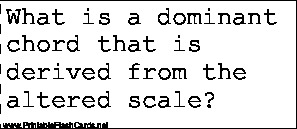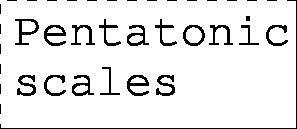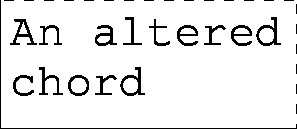

Music theory students can learn from this list of music terminology
There are 48 flash cards in this set (8 pages to print.)
To use:
1. Print out the cards.
2. Cut along the dashed lines.
3. Fold along the solid lines.
Sample flash cards in this set:




| Questions | Answers |
|---|---|
| What is a musical line with no hald steps, used in different styles of folk music wordwide? | Pentatonic scales |
| What is a dominant chord that is derived from the altered scale? | An altered chord |
| What are the three families of the diatonic chords? | Tonic (i, 3, 6), subdominant (2, 4) and dominant (5, 7) |
| What refers to the movement from one family or function of chords to another and is used to establish key centers? | Cadence |
| What is an appropriate description of a typical trombone timbre? | Round, bright, full |
| What is the character of a sound or voice? | Timbre |
| How might a composer use timbre? | To change the sound of an instrument, express sounds in nature |
| Frequency is a measurement of | Sound waves |
| A series of waves produced when an instrument is played | Overtones |
| A series of chords that occur at the end of a section and contain 4 seventh chords | Turnaround |
| What is a dominant chord that will resolve to a diatonic chord that is not the tonic | Secondary dominant chord |
| When an extra dominant chord can create a temporary sense that the diatonic is being resolved is the tonic in a changing key | Tonicized chords |
| What are the four types of modulations? | Direct, prepared, pivot chord, transitional |
| What is the use of an existing chord from a parallel, or of the same route, mode or scal where the particular chord is applied from the parallel key to the original to replace the expected functions | Modal interchange |
| What is the degree of loudness or softness of a music piece | Dynamics |
| Instruments that are make high-pitched sounds and instruments that are _ make low-pitched sounds. | Small/large |
| Which was the earliest family in the orchestra? | string |
| Which was the earliest family in the orchestra? | A piece of wood used for vibration of woodwind instruments. |
| To which family does the saxophone belong? | woodwind |
| A woodwind quartet might include: | Sax, oboe, bassoon |
| What ar the four dimensions of rhythm? | Duration, pulse, rhythm, meter |
| What is a pitch that is usually dissonant and occuring in a strong position within the meter? | Appoggiatura |
| What is the addition of notes to create more beauty or greater effect or to showcase the dexterity and abilities of the performer? | Ornamentation |
| A horror film would best be accompanied by: | A minor leitmotif. |
| In music, what is a 'scale'? | A specific arrangement of notes. |
| One could expect a tragic Italian opera to include: | An aria in a minor key. |
| Based on the title, one could expect Mozart's 40th Symphony in G Minor to sound: | Serious and intense. |
| 'Tonality' is: | The character of the music. |
| What is a repeating pitch or pattern that is quick and continuous? | Tremolo |
| What is an ornamentation completed by rapidly moving between two pitches that are sequential within the key of a particular piece? | Trill |
| A pattern of frequency that is either increasing or decreasing | Contour |
| The person who can identify a pitch or produce a designated pitch without regard to any reference point or standard | Absolute pitch |
| _ and harmonies bring dramatic tension and release to music. | Consonant/dissonant |
| 'Notes that move stepwise' describes when a melody is: | conjunct |
| A countermelody: | is when two melodies create harmony. |
| 'Dissonance' is: | an unstable chord |
| Barbershop quartets use: | homophonic texture. |
| Gregorian chant was most often sung in: | monophonic texture. |
| The song 'Ring of Fire' by Johnny Cash features two trumpet players playing the same rhythms but different pitches. This is an example of: | Homophonic texture. |
| A canon can be described as: | Intricate polyphonic counterpoint. |
| the correct order of increasing dynamics? | piano, mezzo piano, mezzo forte, forte, fortissimo |
| Which is the loudest dynamic? | fortissimo |
| Sforzando means | suddenly loud |
| Which of the following are the lines of the treble clef staff? | E, G, B, D, F |
| 'Enharmonic' means: | A pitch with two names |
| A 'natural sign': | cancels accidentals |
| When added to a note, a flag or beam: | shortens the value of the note by half. |
| Notes are named relative to their duration of a: | whole note. |